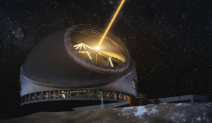
We might expect the masterminds behind giant telescopes to be better than most at seeing the big picture. But it was only recently that the leaders of two planned mega-telescopes recognized that they could move their stalled projects ahead by teaming up rather than competing.
Caught in the crosshairs
Back in 2002, the leadership of the California Institute of Technology and the University of California system conceived of the Thirty Meter Telescope (TMT), a mammoth $1.4 billion, 18-story facility to be built on Mauna Kea, a dormant volcano rising two miles above the Pacific Ocean on the island of Hawaii. The joint venture among scientists in the United States, Canada, India, and Japan promised new views of the universe and would be the largest telescope in the Northern Hemisphere.
Meanwhile, over in Pasadena, the Carnegie Observatories embarked on plans for the Giant Magellan Telescope (GMT), a facility to be built in Chile for approximately $1 billion. Expected to be the largest optical observatory in the Southern Hemisphere and perhaps the world, the GMT attracted partners in Australia, Brazil, Chile, and South Korea.
But while a third giant telescope project, the Chile-based European Extremely Large Telescope, led by a 15-nation European consortium, zoomed ahead, progress on the TMT and GMT stalled. With the telescopes positioned as rivals, funding nations and institutions lined up behind one or the other rather than both, leaving both short of their funding goals, as reported by Science magazine. And while the GMT is under construction, the TMT has faced costly delays as a result of protests and legal challenges from Hawaiians who object to telescopes being built on Mauna Kea, an ancient burial site. The project could be moved to Spain’s Canary Islands.
An expanded scope
On May 21, the leaders behind the two projects announced an agreement to do what they might have done from the start: join forces. Given their main goal of winning funding from the National Science Foundation (NSF) and Congress, they have modified their projects to make them more inclusive. Specifically, they have agreed to give astronomers from any institution worldwide access to the telescopes and also to devote a portion of viewing time to the public.
The “division” between the TMT and GMT “has set back U.S. astronomy a decade,” University College London astronomer Richard Ellis, a former leader of the TMT, told Science. “Let’s turn the corner.”
The partnership comes as the U.S. government is about to embark on a once-per-decade survey to determine funding for astronomy projects. The newly united TMT/GMT teams will highlight their “complementary strengths,” according to Science. Together, they capture both the Northern and Southern Hemispheres. Moreover, the GMT is designed to probe the atmospheres of exoplanets, while the TMT will seek new information on the universe’s first galaxies.
They have reason to be optimistic: In May, Representative John Culberson, who chairs the House Appropriations subpanel that funds scientific projects, allocated $123 million to yet another mega-telescope, the Large Synoptic Survey Telescope, despite the fact that the project’s leaders and the NSF had requested only $49 million. Culberson told Science he believes in “front-loading” funding of large engineering projects to lock in costs and speed up construction.
When organizations frame themselves as competitors, they can become so focused on “beating” their rival that it becomes almost impossible for them to see the virtues of teaming up in the pursuit of shared goals. The sudden collaboration between the TMT and GMT reminds us that rivals may be able to see further and reach higher when they work together rather than apart.




